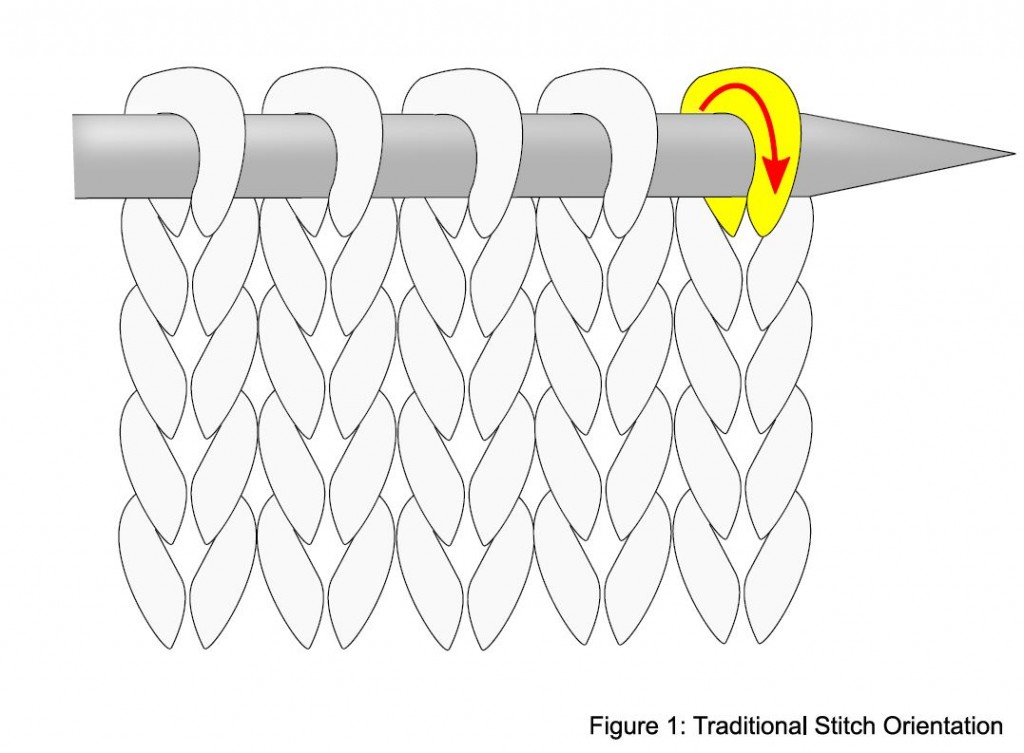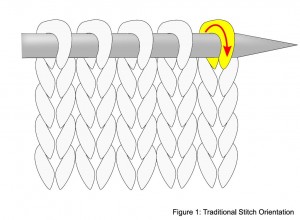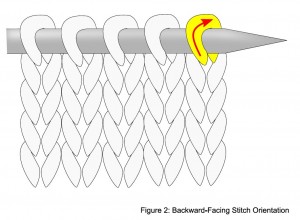
Twisted stitches can be a real challenge for new knitters. The problem generally arises when stitches are oriented incorrectly on the left hand needle. In figure 1 we see the traditional orientation in which the right-hand leg of each stitch is sitting toward the front of the needle. In this position working into the front
Twisted stitches can be a real challenge for new knitters. The problem generally arises when stitches are oriented incorrectly on the left hand needle. In figure 1 we see the traditional orientation in which the right-hand leg of each stitch is sitting toward the front of the needle. In this position working into the front loop produces normal stitches. In figure 2, we see stitches which are “backward-facing” with the right-hand leg sitting to the back of the needle. In this case knitting into the back loop will produce a normal stitch while working into the front loop will produce a twisted stitch.
Backward Stitches
Backward-facing stitches originate on the previous row when purl stitches have been accidentally worked in the wrong direction. New knitters can run into trouble when trying to remember which way to wrap the yarn around the needle to work purl stitches. In traditional purling, the yarn is always wrapped in a counter-clockwise direction – and this is true whether you happen to be a Continental or English knitter. What often happens, however, is that the knitter wraps the yarn in the opposite (clockwise) direction before completing the purl stitch. This slight alteration produces a backward-facing stitch, which can create problems on the next row.
No Frogging Required
When faced with backward-facing stitches there are two simple solutions to choose from. One option is to slip the offending stitch off the needle, twist the right-hand leg forward, then place it back onto the needle. Alternatively, you could work into the back loop whenever a backward-facing stitch presents itself. Whenever possible, go with the later option because it is the simplest of the two repairs and will cause less disruption in the flow of your knitting.
Positive Twists
Twisted stitches can be your friends. When worked purposefully, they add beautiful texture to your knitting. Add columns of twisted stitches to your knitting by intentionally working knit stitches into the back loop on the right side of the work and purl stitches into the back loop on the wrong side of the work. Placing a few reverse stockinette stitches on either side of the twisted stitches will make them stand out beautifully.
By recognizing how stitches are oriented on your needles, you can fix twisted stitches or prevent them altogether. Armed with this knowledge, you can go a step further and take advantage of backward-facing stitches and make strategic use of twisted stitches in your knitting.
Angelia Robinson is a knit and crochet designer residing in Los Angeles whose playful yet elegant designs explore the interplay of shape, texture, and style. Do you have a knitting question for Angelia? Write us (submissions@ilikeknitting.com) and include “Ask a Knitter” in the subject line.





This is helpful for me when I have had to frog many rows at a time and I have picked up the stitches incorrectly.